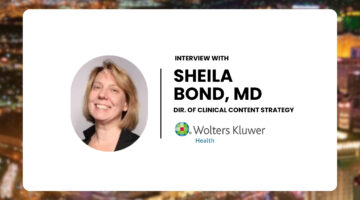
The concept is so simple and practical: regardless of how an individual enters the healthcare or social care system — through the emergency department (ED), primary care office, or a community food pantry — they should be able to easily access all the resources they need to live their healthiest life.
This “no wrong door” approach envisions an integrated system of providers, resources and workflows that make it fast and efficient for any front-line provider to connect individuals to the services they need. Whether it’s medical care for a chronic condition, access to food or housing assistance, or behavioral health services, efficient connections are just a few clicks away.
Yet the current process is much more complicated and disjointed.

Transforming Clinical Content with Ambient & Generative AI
Sheila Bond, MD, talked about the latest trends regarding integration of AI in healthcare.
The food pantry has no means of connecting clients to healthcare services, despite being aware of their health concerns. An ED nurse may know of community-based organizations (CBOs) that provide medically tailored meals or groceries, but what if that nurse is not on shift when the patient comes in? The primary care provider (PCP) might discover the patient can’t afford medication or has no transportation to get to appointments but is powerless to help them address it.
As healthcare leaders and policymakers increasingly recognize that medical intervention alone cannot resolve our nation’s health crisis, the integration of social care into healthcare delivery is essential. The challenge lies in connecting disparate systems to eliminate silos and make social care work at scale.
Through the convergence of proactive policy, advanced technology and strategic public-private partnerships, we can achieve this “no wrong door” vision and deliver a connected, streamlined social safety net that’s more efficient, economical, and effective. Here’s how.
Policy continuity despite political change

Solera Health’s Playbook To Beat Rising Employer Expenses
Solera Health is working to streamline employer contracting with health tech.
While each new political administration may use different language to articulate its priorities, the fundamental intent to address holistic health remains the same. For the Biden administration, that meant focusing on health equity for underserved populations, whereas Trump’s team is focused on broader initiatives for all underserved and vulnerable individuals, regardless of race, ethnicity, or other demographic factors.
This recognition across all political perspectives that everyone deserves access to care is crucial. Regardless of the approach, the reality is that over 100 million Americans — 1 in 3, including half of all American children — rely on social safety net programs, and meeting those needs drives costs for taxpayers, healthcare providers, hospitals, and health plans. Delivering those services efficiently, effectively, and in the most dignified way is everyone’s top priority.
To achieve that requires continuity across key policy areas:
- Chronic disease prevention and management through holistic interventions that address medical, mental/emotional, and social needs. Diabetes, for example, isn’t just a medical condition — there are emotional, lifestyle, and social aspects that cannot be overlooked.
- “Food as medicine” programs that provide access to nutrition education and healthy foods across every socioeconomic sector and geography. Telling someone what they should eat isn’t helpful if they can’t access it because they’re one of 47 million Americans living in food-insecure households.
- Nationwide implementation of policies that reimburse CBOs for providing essential health-related services. Because CBOs operate on razor-thin margins, reimbursement creates sustainable funding to support their vital work that directly impacts health outcomes.
- Integration of social needs screening, referral and follow-up with patients with complex conditions across the healthcare ecosystem, including quality measures and reimbursement models, so that providers and care teams can connect people to services as part of their care — and get paid for doing it.
Technology that enables seamless connection
Practically speaking, the only way to achieve “no wrong door” is to ensure everyone in the ecosystem has universal access to a doorway into the same network.
That includes providers and CBOs — those on the front lines providing the services — but also health plans and health information organizations to facilitate data sharing, integration, and eligibility screening; provide data-informed service delivery; and ensure HIPAA compliance.
But the solution lies not in replacing systems but in creating seamless integrations with existing ones that enable providers to operate within their familiar workflows — their electronic health record (EHR), for example — rather than toggling between separate portals.
With closed-loop referral systems, health plan data and real-time access to community resource information are embedded into the care management process, so providers can automatically verify patient eligibility and match them to resources.
For example, after verifying coverage and entering patient screening data in the EHR, an ED provider could receive an alert that the patient is eligible for food assistance or transportation vouchers. The care team could then directly refer the patient to those services in just a few clicks.
It’s an incredibly efficient and logical model that has potential to transform the way care is managed, delivered, and measured.
Innovative partnerships that fuel collaboration
Bringing together all the entities required is essential for realizing the full potential of “no wrong door.” While these partnerships can be spearheaded by health systems and health plans, some of the most effective are happening at the state level where people can find help with food, housing, utilities, transportation, and more within their local community.
The ideal partnership creates a comprehensive, connected social safety net through collaboration across:
- state departments of health, which provide policy framework and funding
- health information organizations to facilitate data sharing and technical infrastructure
- community action agencies to engage CBOs
- health plans and hospitals that integrate social care into medical care delivery
- technology platforms that enable seamless communication across all participants
In this model, each organization works within their own systems — healthcare providers in their EHRs and CBOs in their case management tools — connected to a shared infrastructure that facilitates efficient, elegant care coordination.
The future vision: Any service through any door
Creating an integrated social safety net requires collaboration across policy, technology, and partnerships. The foundation already exists in current policy frameworks that recognize social determinants of health (SDoH) as essential healthcare factors. With technology becoming increasingly sophisticated and user-friendly, successful models are demonstrating that public-private partnerships can create sustainable systems serving both individual needs and population health goals, while meeting fiscal efficiency goals.
“No wrong door” isn’t just an aspiration — it’s an achievable reality that hinges on continued commitment to holistic intervention, privacy protection, and collaborative problem-solving. Scalability requires ongoing support for innovative funding, technology development that prioritizes integration over replacement, and sustained commitment to public-private partnerships.
It’s only by leveraging the strengths of all sectors with a comprehensive, collaborative approach that we can create the connected, efficient social safety net that all Americans deserve.
Photo: elenabs, Getty Images
Carla Nelson, MBA, is the Senior Director of Healthcare and Public Policy at Findhelp, where she analyzes federal and state policies and translates them into actionable Findhelp strategies that support marketing, product development, and customer and community success. Prior to Findhelp, Carla was Vice President of Ambulatory Care & Population Health at the Greater New York Hospital Association (GNYHA), a trade organization representing more than 160 member hospitals and health systems. Carla earned her Bachelor of Arts in Philosophy, Politics, and Law and her Master of Business Administration from Binghamton University.
This post appears through the MedCity Influencers program. Anyone can publish their perspective on business and innovation in healthcare on MedCity News through MedCity Influencers. Click here to find out how.







